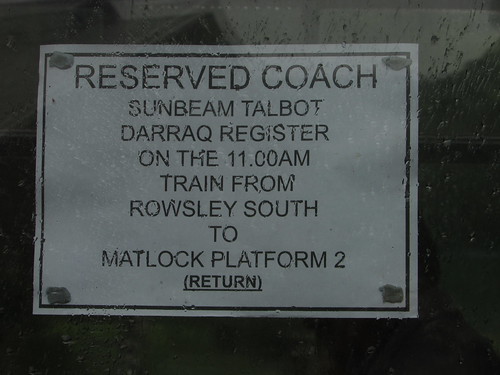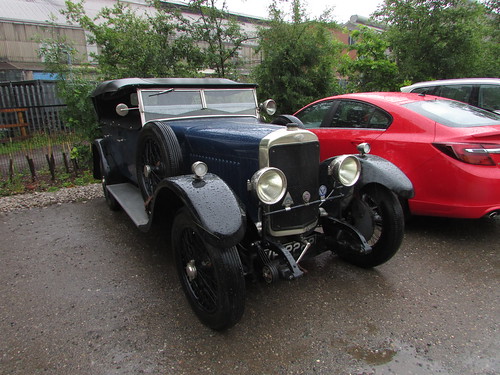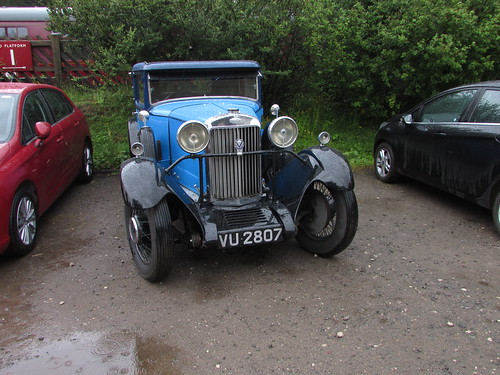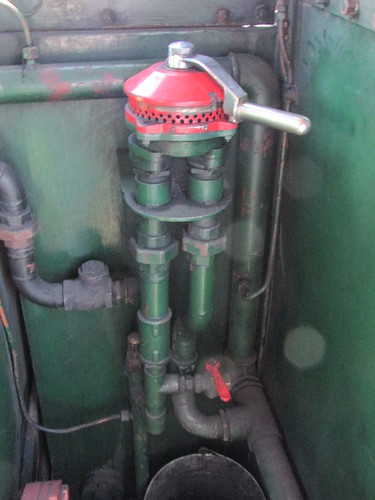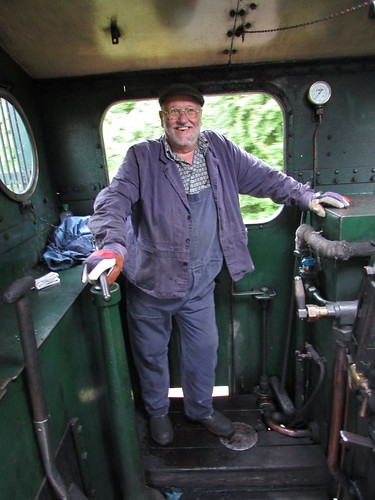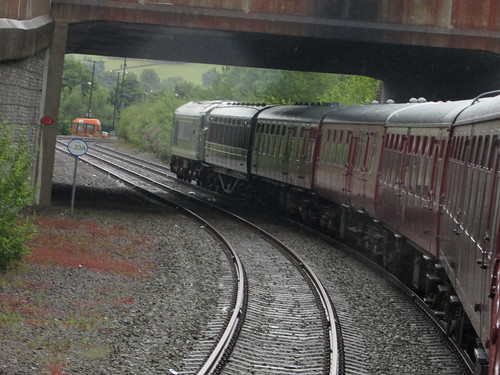On Saturdays and Sundays, the railway usually operates a steam-hauled service but sometimes a diesel railcar is substituted.
Events of Saturday, 1st July 2017
I'd offered to drive 'Cumbria' on the steam service on Saturday, 1st July but on Friday evening I was asked, because of the unavailability of a fireman, if I could operate the diesel railcar instead for the five scheduled round trips of the 'Weekend' timetable. I'd also been told that the 'Bubble Car' had operated the previous 'Midweek' service but that it was low on fuel for a further full day's service so I'd need to use the 2-car set. All three vehicles are normally stabled on the long siding at the side of the Locomotive Shed called the 'DMU Siding'. Since the single unit had been the last to be used, I knew the order of vehicles, from the buffer stop end, would be 51321/51131 and then 55005. So the first order of business was to 'dig-out' the 2-car set from 'behind' 55005. Fortunately, the Signalman has arrived to work the 'box' for the shunt. The moves were:-
1. Fire-up the single-unit and shunt it to the running line, just clear of the crossover by the signal box and 'tie it down'.I've omitted all the details of starting, testing and shutting down the units, all the walking about from unit to unit and and all the clambering from track to cab and back again. By the time I'd returned to the station and the waiting 2-car set, I felt I'd already done a day's work!
2. Perform the daily exam on the 2-car, start it up and position it in platform 1, so that the Guard could unlock the passenger doors and prepare the train as necessary.
3. Shunt the single unit back to the DMU Siding, far enough towards the buffer stops to allow the 2-car set to be stabled behind it at the end of traffic, then shut it down.
The rest of the day was spent carrying out the five round trips to Shenton. Of course, some of the passengers were disappointed that the trains were not steam hauled (but none more than the writer!). Fortunately, the weather was kind with blue skies, wispy clouds and warm sun, as you can see from the picture below taken at Shenton.

51131 (nearest camera) and 51321 ready to work back to Shackerstone from Shenton.
51131 is the most recently 'outshopped' vehicle, with a repaint and extensive work carried out and looked splendid. The picture below is a detail of the underfloor-mounted Stone's 24 volt d.c. generator which charges the 24 volt battery used for all lighting, indications, engine starting and the electro-pneumatic control system via a Stone's 'IONUM' Generator Control Panel.
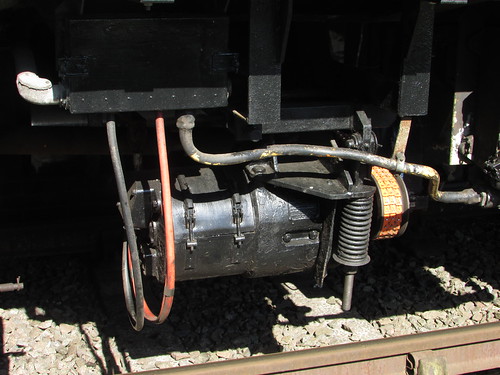
Detail of Generator on 51131. Note triple drive belt on the right.
In the 1950s, British Railways designed various patterns of diesel multiple unit and the large numbers required to eliminate steam working on suburban and secondary routes meant that manufacture was divided between a number of works. The three cars preserved at Shackerstone come from three different suppliers (Gloucester Railway Carriage and Wagon, British Railways Derby and Birmingham Railway Carriage and Wagon) but can be used in multiple. The early sets were 2-car, with a Driving Motor Car attached to a Driving Trailer Car. The motor car was equipped with two underfloor bus engines, controlled together by an Electro-Pneumatic (E.P.) control system. Various configurations were produced including 3-car sets (with a non-driving trailer in the middle) and, for lightly-used lines, a single motor car with a driving compartment each end (always called 'Bubble Cars'). The power came from underfloor-mounted modified bus engines.
 One of the underfloor mounted 150 h.p. adapted bus engines.
One of the underfloor mounted 150 h.p. adapted bus engines.
Completing the 'diagram' of five round trips was certainly easier than on steam, but I was still pretty tired by the end of the day.
Events of Tuesday, 4th July 2017
A couple of days later, I was back at Shackerstone as driver of the scheduled diesel railcar service of four round trips. At the end of service on the Sunday, I'd left the 2-car set on the DMU Siding and expected an easy start - just check levels, perform daily 'Exam', start up and drift down to the platform. However, I still arrived on site early, because you never know what you'll find. What I found was Steve A. saying that, because of the size of the school party booked on the second train from Shackerstone, arrangements had been made to fuel the 'Bubble Car' (which I'd left, low on fuel, behind the 2-car set) and then run as a 3-car set. I was told that Adrian would fuel (from the locked-up oil drum mounted on a wagon at the north end). Space was restricted at the north end, so I knew that I'd have to take the 'Bubble Car' down on its own and attach it to the 2-car set after fuelling.
So, I'd a bit of a shunt to do, after all! I discussed the moves with the Signalman and 'prepped' the 2-car unit. When I'd sufficient air pressure built up in the air receivers to operate the E.P. (Electro-Pneumatic) controls, I shunted the set to the running line, clear of the crossover by the signal box, applied the handbrake and made it safe to leave. Then it was across to the adjacent DMU Siding to start the 'Bubble Car'. Once I'd sufficient air, I drifted through platform 1 to the north end and parked the vehicle to Adrian's instructions. He said he'd refuel whist I moved the 2-car set into the platform. So I walked back through the station to the waiting 2-car set on the running line and moved it to platform 1 before walking to the north end to pick up the now-fuelled single car unit. I drove back to the station and slowly closed up to the waiting 2-car set. Steve was on hand to couple up - not a trivial task. I described the various connections between vehicles in the section 'The Technical Stuff' forming part of the post Battlefield Line 1940s Weekend (June 2013).
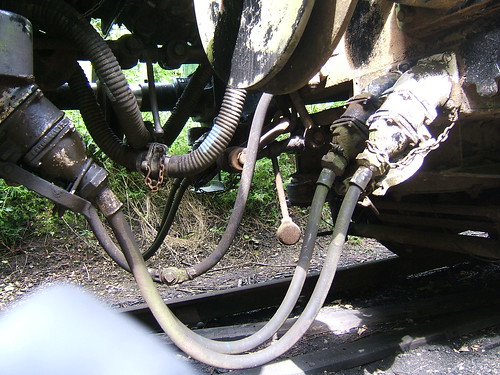
Details of the interconnections between vehicles.
Unfortunately, Steve couldn't obtain a proper seal on the Control Air Palm Coupling, because of the poor condition of the 'washer' or 'rubber'. After Adrian also had a look, we decided to uncouple and run the first train just with the 2-car set, whilst Adrian attempted a repair. So, having struggled to couple the units, there was a further struggle to uncouple them! To make sure everything was back as it should be, I repeated the cab tests.
We set off, as a 2-car set, with the first train of the day, a few minutes late. With 600 horse power on a 2-car unit, acceleration was quite good, so, despite needing to observe the same speed limits as the steam trains, we were about right time into Shenton. After our wait in Shenton, our departure on the return journey was right time, as was our arrival at Shackerstone.
Whilst I was down the line, Adrian had moved the 'Bubble Car' onto platform 2 so that platform 1 was clear for our approach. I discovered that he's not found a replacement 'washer' for the palm coupling but he'd had the same idea that had occurred to me - couple the 'Bubble Car' onto the south end of the 2-car set, rather than the north end. The damaged seal at the north end could remain isolated (there's a white-painted shut-off cock for this purpose). I moved the 1-car unit across from platform 2 and gently buffered up, this time at the south end of the 2-car set. The large school party were already aboard the 2-car set so I was relieved that I managed to just 'kiss' the large buffers together. I was even more relieved when the coupling-up was completed and there were no air leaks. All that remained was to repeat the cab tests to ensure that I had control of all three coaches forming the train (and all six engines!).
Including teachers, the primary school party totalled around 140 and we also carried our individual passengers, who were able to spread themselves out in the leading 'Bubble Car' which had just been attached. Once again, departure was a little late, but we'd recovered this by the time we arrived at Shenton. The well-behaved children formed up on the platform and, when everybody was safely off the train, the School Party were led in a 'Crocodile' to the nearby Battle of Bosworth Site.
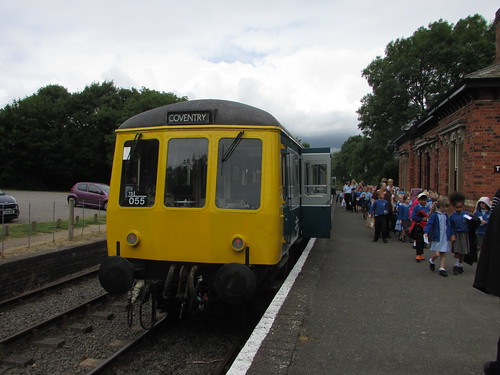
On arrival at Shenton, the School Party were led in a 'Crocodile' to the Battlefield Site.
Excitement over, we left Shenton right time and made our booked stop at Market Bosworth before continuing to Shackerstone.
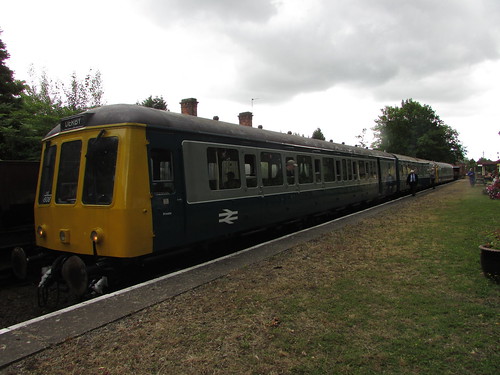
After taking the school party to Shenton, the 3-car set pauses at Market Bosworth on the return to Shackerstone.
We learnt that the School Party were not returning by train but continuing by coach after their visit to the Battlefield so the Guard elected to carry out the remaining two round trips with only the 2-car set. Adrian kindly 'unhooked' the 'Bubble Car' which I drove back to the DMU Siding and shut down, now fuelled and available for future service.
The last two trips were uneventful, except for the Number 1 engine on car 51131 deciding to shut down a few times as we were moving. It's possible to use electric restart from the cab which is generally effective but on a couple of occasions, it wouldn't restart remotely. In such cases, restart has to be attempted from the ground (as in first startup in the morning) which I performed once at Market Bosworth and once at Shackerstone. Starting appeared a little 'sluggish' but, once running, the engine sounded perfect. Had I been unable to restart the engine, the failed engine would have been isolated and the associated final drive disconnected, allowing the DMU to carry on with the remaining engines.
At the end of traffic, the Guard made sure windows were closed and all doors (except Driver's doors) locked then I stabled the set in the DMU Siding and shut down, with the handbrake firmly applied. The problem with the engine was written-up in the daily record sheet at the end of the day. Checking through the train, I found a discarded child's ticket, shown in the picture below. I went round locking Driver's doors, and clambered down to the ground, locking the final door. I then made my final ground level inspection, isolating the battery in each vehicle, checking all lights out and visually inspecting the engines and all underfloor equipment.

An Edmondson pasteboard Child Ticket issued on the day. Note the triangular area on the left punched out by the Ticket Inspector's ticket clipper to show that the ticket has been used.
Related posts on this website
To see all my posts about DMU at the Battlefield Line, select Label 'DMU'
or click here.
To see all my posts about the Battlefield Line, select Label 'Battlefield Line'
or click here.
My photograph albums
DMU Days at the Battlefield Line (51131/51321/55005 in 2017).
Midweek DMU Service (55005 in 2013).
Bubble Car (2011).
Shackerstone DMU Group (Earlier pictures from 2007 onwards).
All my Battlefield Line albums.
